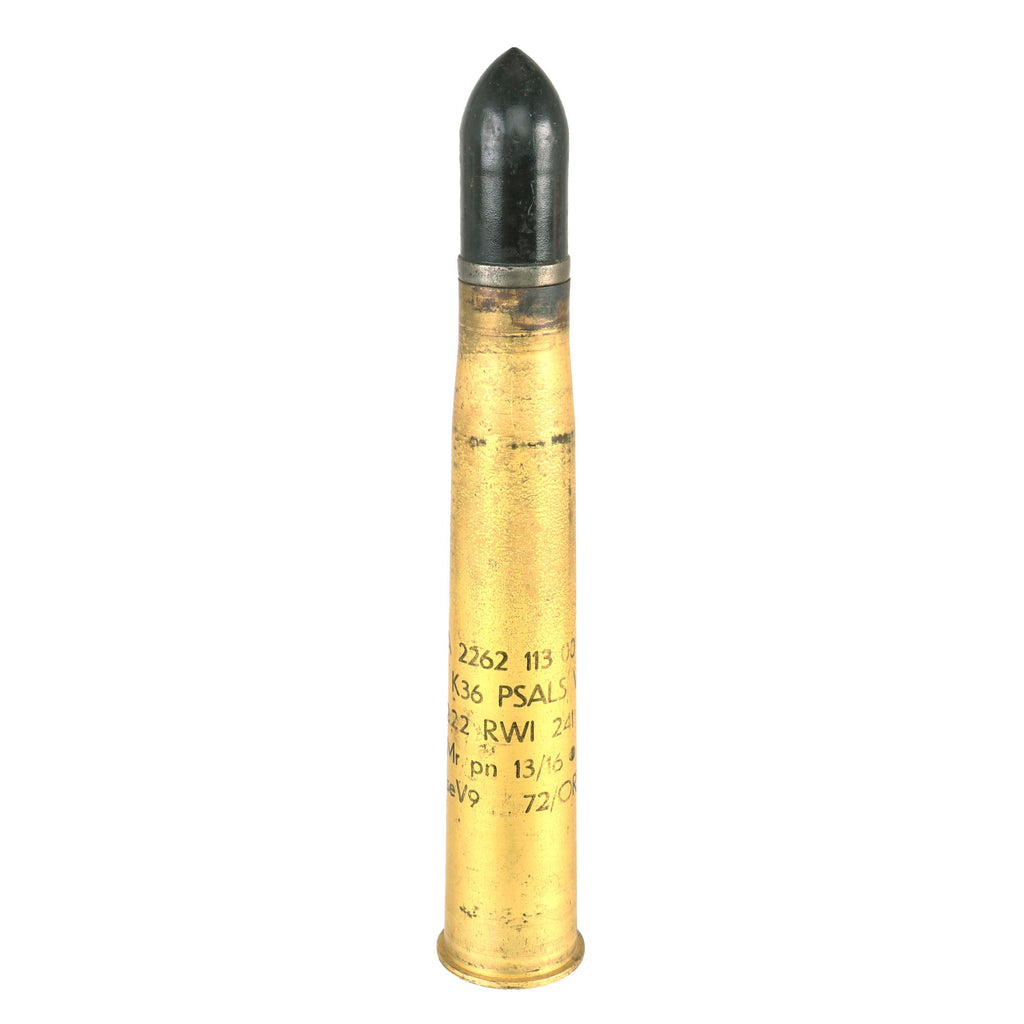Item Description
Original Item: Only One Available. This is a very good condition, totally inert -BATF compliant, PAK 36 37mm Armor Piercing round in its original shell casing. Offered in very good condition with full German wartime markings in black on the side of the shell, which read:
A 2262 113 00
37 K36 PSALS VJ
222 RWI 241
2Mr. pn 13/16
Ase V9 72/OR
There are also markings on the base of the shell, which read:
37 K/36
AR2/44RL
The shell measures approximately 13 1/8 inches long, and the round is currently removable from the casing. Ready to display!
Unloaded or dummy grenades, artillery shell casings, and similar devices, which are cut or drilled in an BATF-approved manner so that they cannot be used as ammunition components for destructive devices, are not considered NFA weapons. This example is in total compliance and is NOT AVAILABLE FOR EXPORT.
The Pak 36 (Panzerabwehrkanone 36) is a 3.7 cm caliber German anti-tank gun used during the Second World War. It was the main anti-tank weapon of Wehrmacht Panzerjäger units until 1942. Developed by Rheinmetall in 1933, it was first issued to the German Army in 1936, with 9,120 being available by the beginning of the war in September 1939 and a further 5,339 produced during the war. As the predominant anti-tank gun design in the world during the late 1930s, demand was high for the Pak 36, with another 6,000 examples produced for export and the design being copied by the Soviet Union as the 45 mm anti-tank gun M1932 (19-K) and by other nations such as Japan.
It first saw service during the Spanish Civil War in 1936, where it performed well against the light tanks of the conflict. It was first used during the Second World War against Poland in 1939 and had little difficulty with any of the Polish tanks. The Battle of France in 1940 revealed its inadequate penetration capability against French and British heavier tanks, particularly the Char B1, and especially the Matilda II, receiving the derisive nicknames "Heeresanklopfgerät" from its crews, but it sufficed to defeat the bulk of the Allied armor in the campaign. The invasion of the Soviet Union brought the Pak 36 face to face with large numbers of T-34 and KV-1 tanks, which were invulnerable to its fire. However, 91% of the Soviet tank forces in 1941 consisted of lighter types that lacked sufficient armor to defeat the gun, and the Pak 36 knocked out thousands of such tanks.
The Pak 36 was replaced from late 1940 onward by the 5 cm Pak 38 anti-tank gun and from November 1941 by the 7.5 cm Pak 40. This process was accelerated by the engagements with the modern Soviet tanks, and Pak 36 production ceased entirely in early 1942. The introduction in 1943 of the Stielgranate 41 shaped charge gave it the ability to punch through the armor of any Allied tank, but the ammunition's short range made the Pak 36 crews vulnerable to enemy fire and could not solve the gun's basic obsolescence. German paratroopers employed the gun due to its low weight and consequent high maneuverability. The Pak 36 was also used by Axis-allied, second-line, garrison and training units until the end of the war.
- This product is not available for international shipping.
Totally inert, cannot be converted to an explosive device, not available for export. This item is completely legal within the USA. International Military Antiques, Inc observes all Federal, State and Local laws. Everything for sale on ima-usa.com is completely legal to own, trade, transport and sell within the United States of America.
All deactivated ordnance sold by IMA, Inc is engineered to be inoperable according to guidelines provided by the US Bureau of Alcohol, Tobacco, Firearms and Explosives (BATF).
- Not eligible for payment with Paypal or Amazon











